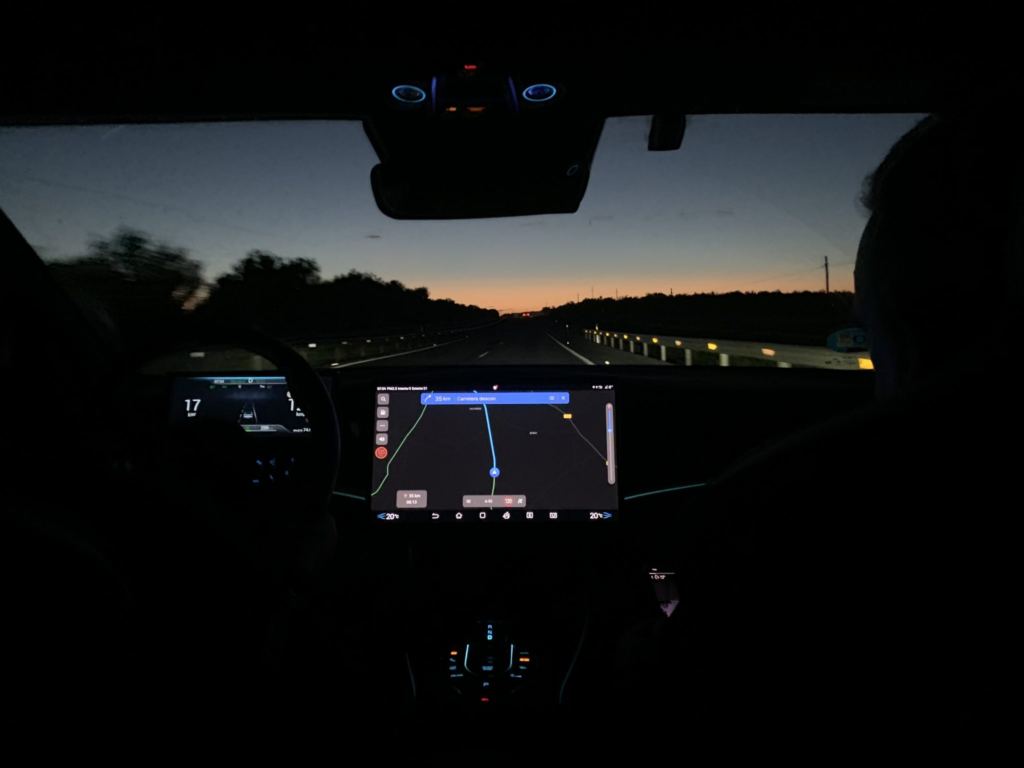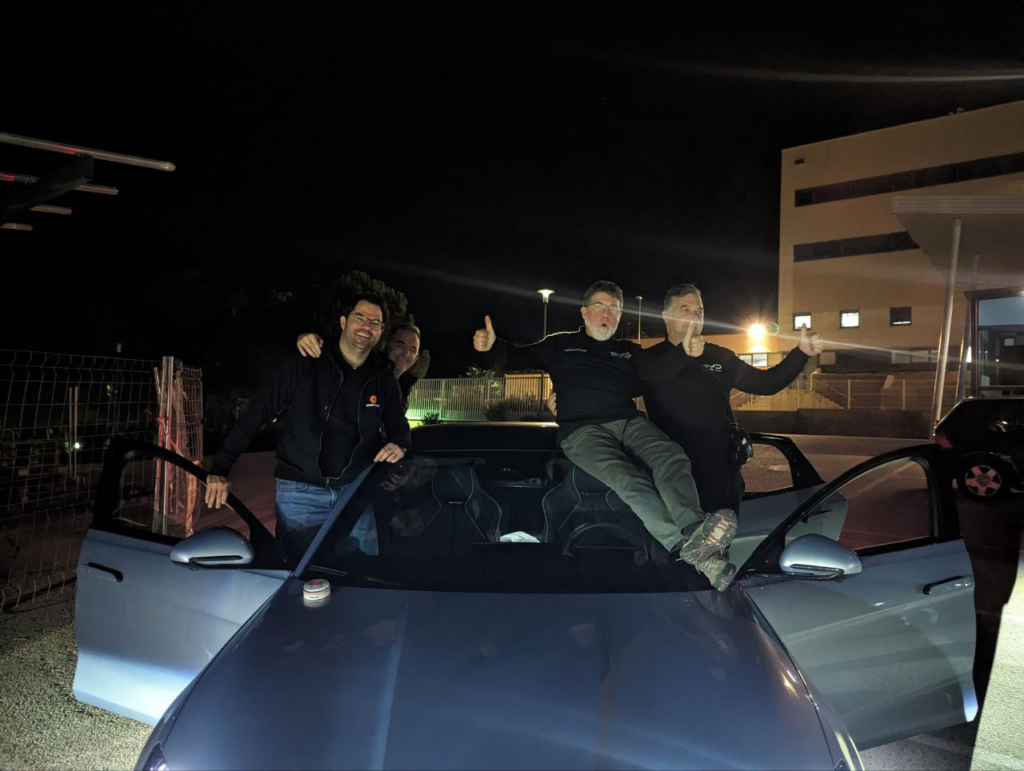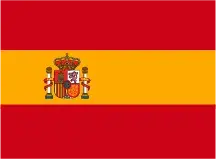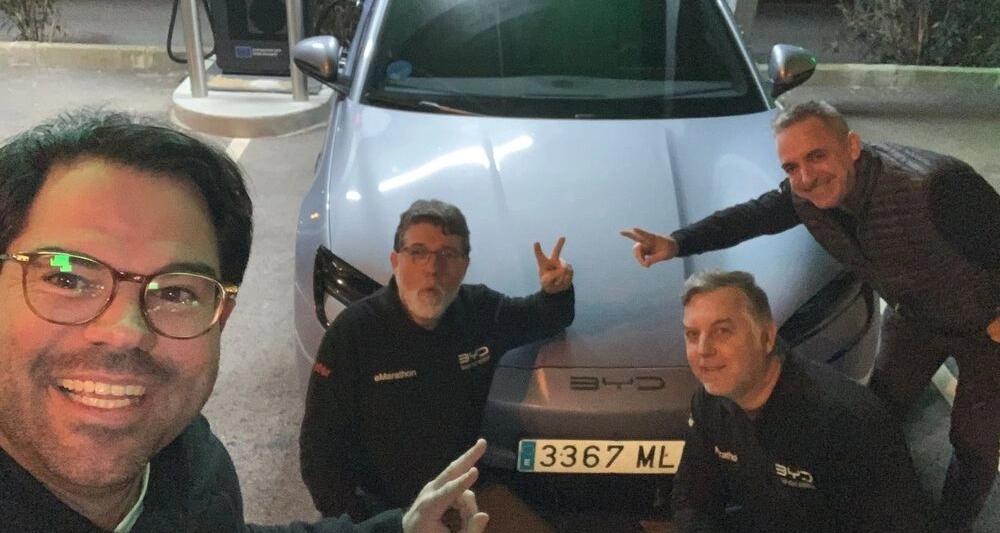Four eMobility specialists set themselves the goal of covering 3,000 kilometers in 36 hours across the Iberian Peninsula, which is why they embarked on their journey on January 20th and made it a reality.
“Four drivers, one BYD Seal, nine stops, eight operators, and eight different charger manufacturers” was the slogan of a challenge that not only caught the attention of the sector but also of those looking to join the electromobility trend.
Ferran Menescal Miralles, Sales Manager Iberia at Kempower and a reference in the world of sustainable mobility, recounts firsthand to Mobility Portal España the chronicle of the 36-hour journey.
The first point to address was to find “a car that was not Tesla, to avoid the feeling that it would be easier.”

Looking for the balance between range and charging speed, the experts Ferran Menescal Miralles, Pere Sòria Alcàzar, Miquel Àngel Sòria Alcàzar, and Daniel Gracia Ariz, came across the BYD Seal.
The Asian model met their demands and helped to debunk prejudices surrounding Chinese brands.
All this, while also achieving a balance between “making few stops and achieving lower consumption.”
When planning the challenge, they decided it would be best not to go through cities with the highest number of charging points, such as Madrid and Barcelona, so they chose to “skirt the entire peninsula.”
But that was not all, because to add more difficulty to the challenge, they added a destination: Portugal.
“We crossed the country from north to south. We entered through Galicia and exited through Andalusia,” explains Menescal Miralles.
A journey across different operators
So, faced with the question: Is it possible to travel thousands of kilometers in an electric car without having to suffer?
The answer turns out to be “yes, it is.” The four electric mobility specialists demonstrated it.
The first stop to recharge the BYD Seal was Ionity in Zaragoza, and then they continued: Iberdrola in Burgos; Zunder in Puebla Sanabria; Powerdot in Oporto; EDP in Grandola; Endesa X Way in Seville and Cullar; Tesla in Aguadulce and Aldea; and finally, Wenea in Carlet.

“The range of the electric car is 400 kilometers (km) and within that distance, there is always a plug available. The estimated recharge time varied between 20 minutes and an hour,” reveals the spokesperson.
In this sense, he emphasizes that when it comes to long stops, it is due to two reasons: one linked to arriving at the point with the battery very low, and the other with the recharge coinciding with lunch or dinner time.
One recommendation that the team of specialists provides for those who are not yet so familiar with the electric car is to “always charge it between 10 per cent and 85 per cent.”
Was the challenge met to the letter?
The travelers had ups and downs throughout the journey, which caused them to arrive at the destination point 49 minutes later than initially established.
This is due to several factors:
On the one hand, the group encountered a “quite large” fog bank in Portugal that made them have to reduce speed, although after passing the obstacle, they could not regain their previous pace.
And in the Oporto area, where they drove around 8:30 in the evening, they encountered a “great traffic of people” that also caused delays.

Story of the eMobility challenge and its protagonists
It is not the first time that the team has immersed themselves in this challenge.
Last year they achieved the goal of 2,000 km in 24 hours, and in this new edition, they set out a somewhat different roadmap.
When outlining the scheme, the experts considered different options “in case any point did not work.”
Although this foresight was not necessary because plan A always worked for them.
Furthermore, a determining factor was the distribution of tasks, in which each member had a mission:
“Pere had the Excel with the car’s consumption and a forecast of how the optimal scenario should be to reach the next charger, while Dani was our expert on the BYD Seal,” recalls Menescal Miralles.
And he continues: “Miquel was in charge of studying the weather and the terrain’s orography, that is, he knew if the stretch was uphill or downhill.”
“In my case, my tasks were specific: to have all the possible applications to recharge the car and to start the recharges at all the stops,” he adds.
This last point is not insignificant, as when traveling on uphill roads, there is greater demand and consumption of the vehicle’s range.
The BYD Seal in depth
The Chinese electric car company BYD (Build Your Dreams) became the world’s leading manufacturer of plug-in cars last year, reaching over five million units accumulated.

With the Seal, the company has already launched five models in Spain since its arrival in 2023.
These vehicles come equipped as standard and not only aim to dispel the idea that Chinese cars “do not match up to European ones,” but also aspire to be the next car of the year.
It is a mid-size sedan measuring 4.80 meters long and aims to compete directly with the Tesla Model 3.
Does winter increase the difficulty?
The planned date for the challenge was November 2023, but they had to postpone it.
The BYD Seal had just been launched and there were no units available, so they changed the challenge to January.
“The best time would have been autumn or spring with temperatures between 15 and 20 degrees,” indicates the executive and eMobility influencer.
But the reality is that there are “drawbacks” for each season.
In winter, upon reaching the charging point, the battery might not be at the ideal temperature, and the charging would be slower.
Meanwhile, in summer, chargers, being exposed to the sun, tend to heat up, decreasing their power.
Trip assessments
Menescal Miralles focuses on three aspects to summarize this challenge that aims to demonstrate to the world the autonomy of electric cars.
First, it is possible to travel with a car that is not Tesla or a vehicle that charges a lot of power; second, the BYD Seal was able to connect through many operators; and third, all operators had ultra-fast charging.
“This demonstrates an advancement in the electric car and the expansion of charging points in the country,” points out the expert.

Another point he highlights relates to Spain sharing with Portugal different mobile applications that streamline the journey “without having to do anything special, it is as if we were traveling on Spanish soil.”
Strategies to implement to attract eMobility users
The challenge highlighted certain criteria to consider that could lead more Spaniards to switch to eCars.
The specialist focuses on payment methods and considers:
“Chargers lack payment by Visa, that is, integrated payment. This way, any user could charge with a credit card without needing to download an application.”
The spokesperson announces that “this is an issue on which the European Union places great emphasis and which will be mandatory starting this year.”
Another “criticism” that Menescal Miralles raises relates to the autonomy of cars being “more real.”
That is, sometimes “500 km of autonomy appears when in reality, at most, you will make 400 km.”
Lastly, he proposes the incorporation of new technologies within car operating systems.
In this context, the expert states:
“This axis is fundamental because otherwise, electric mobility will be a failure. Brands would have to put themselves in the user’s shoes, for example, showing the real autonomy.”
“It should also be implemented that the car shows all the charging points around and their status, since many times we see that there is a plug but when we get there it does not work or is occupied,” he adds.
In search of new formulas

Both through social media and personally, the four specialists received constant support during the 36-hour journey.
At the end of the challenge, “we realized that the fans of the electric car were more than we thought.”
So as soon as it ended, they turned to thinking about how to make the next challenge more massive, bringing together different personalities from the sector.
“We want to create a formula that involves more people and that more people can enjoy it. Additionally, we would like to incorporate the electric truck into these challenges because we believe it will have an important role,” affirms the Sales Manager Iberia at Kempower.







